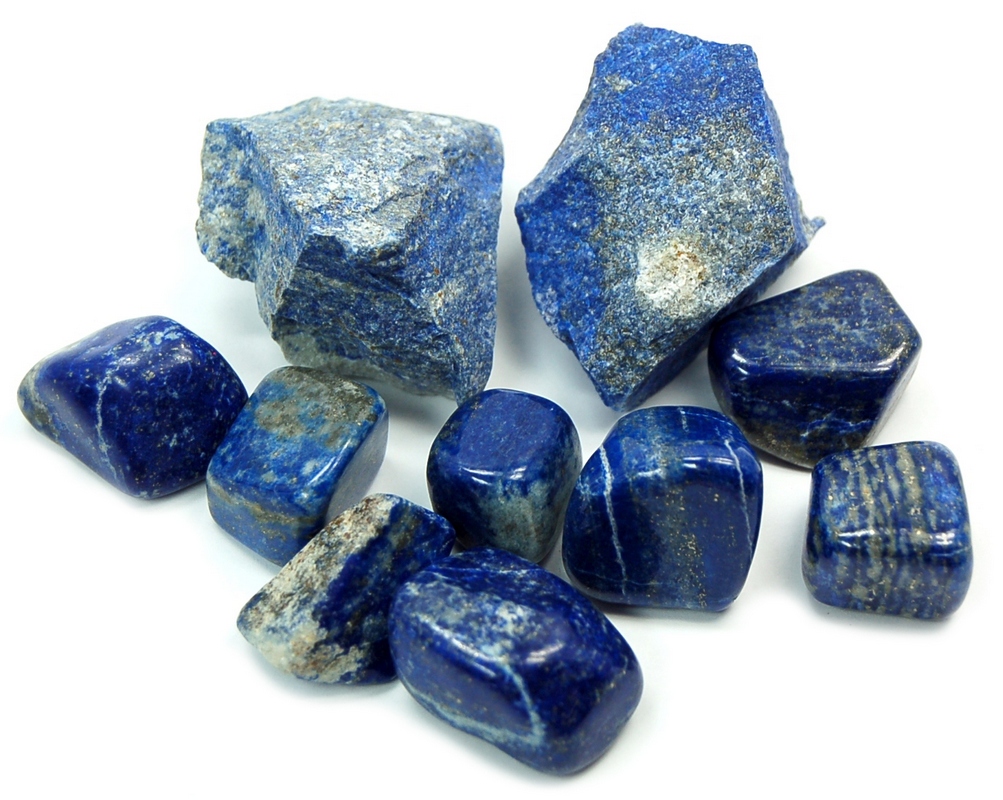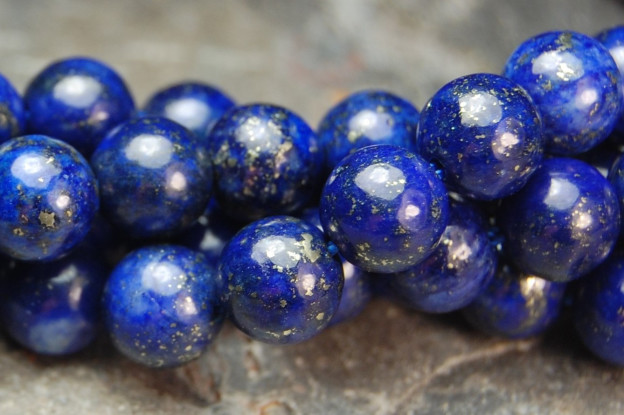
Extracted and used for 7000 years, lapis lazuli is one of the most popular rocks, in mineralogy, jewelry and litho therapy. Its millenary history is fascinating, and its multiple powers and virtues make it a stone of a thousand and one riches. In this new article, let’s go to the discovery of the beautiful “azure stone”…
Mineralogical properties of lapis lazuli
Lapis lazuli is a metamorphic rock of very variable composition that is most often formed in limestone. It consists mainly of lazurite (25 to 40%), which gives it its deep blue color, between azure and ultramarine.
Lapis lazuli is typically dotted with veins of pyrite that have sometimes been confused with gold powder. Other minerals may come into its composition, primarily calcite and sodalite, but also augite, mica or hauynite.
The lazurite present in the stone displays a cubic symmetry. This form of cubic dodecahedron crystals can reach up to 5 cm in diameter, but the pure and geometrically shaped pieces (as in the photo) are very rare.
Although it has the appearance of a hard stone, lapis lazuli has a relatively low hardness of 5.5 to 6. It has a perfect cleavage and a refractive index of 1.5. Variant according to the pyrite powder content, the stone has a density ranging from 2.7 to 2.9.
Lapis lazuli is an opaque; matte- colored stone that derives its value from the intensity and dominance of its blue color. The more it contains veins of white calcite or splinters of pyrite, the less valuable it is.
The rarest and most beautiful lapis are found in Afghanistan, especially in the province of Badakhshan, where the stone has been mined for thousands of years. Those of lesser value generally come from Russia, the Lake Baikal region and Siberia. The deposits of Chile, located in Ovalle, extract a paler variety of the stone (note in passing that Lapis lazuli is the “national stone” of the country).
The etymology and the meaning of the word “lapis lazuli”
The name of the stone is composed of the Latin words “lapis” (which means “stone”) and “lazuli” (which means “azure”). The term lazuli comes from the Persian lâdjaward , itself derived from Sanskrit ” raja farta “, which means “portion of king” (and which indicates the almost sacred value granted to this mineral). The Persian term became lazul in arable, then lazulum in Latin. Literally, lapis lazuli is therefore “the azure stone”.
But the stone has borne various names over the millennia. In antiquity, it was not unusual for it to be confused with another blue stone: sapphire. This was for example the case of Pliny the Elder, Roman author of the first century, but also of Theophrastus in the third century BC. JC and Georgius Agricola in the fifteenth century. The latter described the stone as a sapphire with golden spots, which reminded them of a sky studded with stars.
When it was introduced to Europe from the 5th century AD, it was also referred to as the ultramarinum. This Latin term, which translates as “overseas”, then referred to the distant provenance of the mineral, from beyond the seas. This name was given to the pigment (used in painting) made from lapis lazuli.
Lapis lazuli in history
A multitude of archaeological sites indicate a very ancient use of lapis lazuli, which dates back at least to the Neolithic period (7th millennium BC). It is found in the form of beads, pendants, daggers, ornaments, and amulets. It was obviously the object of a vast commercial network, between Afghanistan, the Valley of the Indus, Mesopotamia and Egypt.
Buy Metaphysical Products Online
For ancient civilizations in the Near East and Egypt, lapis lazuli was the true gemstone, more prized than gold itself. Although it is today relegated to the rank of semi-precious stone, it is not exaggerated to say, like Michèle Casanova , that the place it occupied then is that of diamond in modern societies .
Lapis lazuli is at the peak of its symbolic and physical value during the Bronze Age, in the middle of the 3rd millennium. The Sumerians call it “the stone of stones” and locate the palace of their “Great Goddess” under a mountain of lapis lazuli. Its ultramarine blue dotted with golden stars evokes the sky and its supernatural powers. There are beautiful lapis lazuli artifacts from this period, including the tombs of Ur’s Royal Cemetery in Iraq, Mari and the Royal Palace of Ebla in Syria. It is the stone of elites, princes and gods.
It is then used to create a multitude of ostentatious objects (statuettes of animals, seals, amulets, etc.) and it is lent powerful virtues. She is reputed to repel the forces of evil and she symbolizes perfection. It is in this context that in the 3rd and 2nd millennium spreads in the Middle East and Egypt, the idea that “to own a parcel of lapis lazuli, it is to possess a parcel of divine. “
Lapis lazuli is therefore the symbol of power, spiritual and political. She is at the same time the “stone of the gods”, in particular of the Egyptian goddess Isis, and the “stone of the Pharaohs”. The latter fashioned it in a thousand ways (amulets, scarabs, ornaments …) and used it among others to make the eyes of their statues and statuettes. The Louvre Museum in Paris exhibits, for example, the statue of Ebih-II, whose pupils were encrusted with lapis lazuli. The funerary mask of Tutankhamun is also encrusted with lapis lazuli, in the eyebrows.
In Greco-Roman antiquity, lapis lazuli does not occupy a truly remarkable place. The Romans lend it aphrodisiac virtues, and use it as an antidote to snake bites. Besides that, it is ground and used as a cosmetic. It is this use of stone that will develop later in medieval Europe.
From 1400, lapis lazuli is mainly used to make a pigment used in painting: ultramarine blue. It is this pigment which will be used, for example, to realize the sky of the Sistine Chapel in Rome.
It is extremely expensive but will remain in common use among painters until the nineteenth century, date from which it is replaced by a synthetic pigment.
Still available today, the prices of this natural ultramarine or “ultramarine” can reach 20,000 € per kilo, depending on its quality and provenance.
Use of lapis lazuli in litho therapy
The crystallized lapis lazuli is a very powerful stone, but it is quite rare and therefore relatively expensive. For best results, use lapis lazuli with a strong ultramarine blue color and pyrite chips with lighter ones and white veins.
Virtues of lapis lazuli against physical ailments
At the physical level, lapis lazuli is a stone of balance, calming, regulation and repair. In the middle Ages, the stone was known for its rejuvenating action on the body, and it was said that it allowed maintaining healthy limbs.
It is a beneficial stone on many levels. It helps in different types of eye disorders by improving the functioning of the eyes and particularly affects the night vision. Its energetic action helps to fight against certain allergies. It is also recommended to lower fever.
It is very effective in treating the kidneys because it regulates the level of water in the body. Its medicinal properties are manifested especially in the bladder, the digestive system, the mouth and the stomach. It calms the vomiting, relieves the painful menstruation and maintains the endocrine glands. But that’s not all…
Skin disorders
Lapis lazuli is especially recommended for insect stings or skin rashes. The calming effect of its cold blue reduces the pain and helps to reduce inflammation. It is also recommended in case of burns. You can use it to massage and relieve the affected part. In general, it strengthens the skin and helps fight against diseases affecting this organ (allergies, eczema, etc.).
Hair and nails
It is from the basic chakra (or root chakra) that the lapis lazuli works on the acceleration of the hair regrowth and that of the nails. It also helps to solve the dandruff problems and allows having beautiful hair. You can use an elixir of lapis lazuli for this purpose.
Throat and respiratory system
When placed or worn at the throat chakra, lapis lazuli is particularly beneficial to this area of the body. It plays a role in strengthening the lungs, fortifies the throat, activates the functioning of the thymus and provides help in diseases of the pharynx.
The stone is known to stop coughing and sneezing. In particular, it reduces the inflammation of the tonsils and the area between the throat and the upper part of the lungs (the bronchi, the pharynx, etc.). It is a recommended stone for asthmatics.
Hypertension
Lapis lazuli strengthens and regulates blood pressure. It is beneficial for people suffering from high blood pressure. However, it is all but an asset for those who have low blood pressure. The latter are advised not to carry the stone, nor to keep it in their rooms during their sleep.
Migraines and headaches
Lapis lazuli is known for its ability to soothe headaches. You can take advantage of its healing action by providing a roller and applying it on the painful areas of the head or cervical. To prevent the recurrence of migraine, sleep with a lapis lazuli stone under your pillow for a few days.
Hearing and tinnitus
Lapis lazuli is reputed to be a stone beneficial to the auditory system. It helps in case of loss of hearing. For people with tinnitus, it is advisable to massage the ear area with a lapis lazuli, in order to reduce the volume and intensity of whistling or ghost noise.
Psychic and psychological virtues of lapis lazuli
On a psychological and spiritual level, lapis lazuli elevates the soul and stabilizes the mind. It is a stone that brings wisdom, self-confidence, intuition and creative expression. It helps introspection, inner discipline and allows being at once more vigorous, more concentrated and more serene.
A symbol of protection, lapis lazuli helps you through difficult moments and situations. He is able to revive the courage of his owner, free him from his anxieties and relieve his stress. Lapis lazuli extinguishes anger, brings peace and serenity, and makes it possible to confront the truth with objectivity and clarity.
Spiritual elevation and creative expression
The appearance of the lapis physically reveals its celestial power. It allows us, indeed, to merge in the starry vault to better understand our position in the universe. The stone thus plays a role in improving the sharpness of the mind and stimulating the creative expression. Being an excellent diagnosis of deficiency, she also helps in the correction of weaknesses psychic and psychological.
Courage and self-confidence
Lapis stone is best suited to shy, introverted and withdrawn people, as it enhances self-confidence through self- acceptance. Being a symbol of a strong personality and hope, it gives courage to people wishing to move forward and exceed their limits. It also shapes humor and spread, and presents itself as the ideal stone in all areas of communication.
Memory of dreams and lucid dreams
Lapis lazuli, as a stone promoting inner vision, also facilitates the memory of dreams, their interpretation, and the advent of lucid dreams.
Depression and anxiety
Lapis lazuli helps to harmonize the different physical, psychological, and spiritual planes and prevents imbalances that are likely to cause malaise and the appearance of depressive states. It helps to overcome depression and get rid of anxiety and old fears.
Opening of the 3rd eye
It is sometimes recommended to wear lapis lazuli as a ferroniere in the middle of the forehead because it opens the third eye and stimulates the inner vision, the intuition and the higher faculties of the mind. Lapis is known for its ability to activate clairvoyance and promote radiesthesia research. This is a stone capable of connecting the higher self with the divine guide and facilitating meditation.

